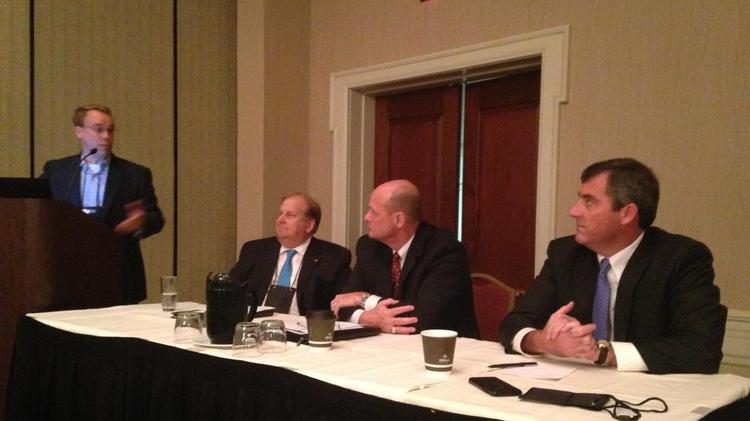Nov 4, 2015, 12:18pm EST Updated Nov 4, 2015, 1:26pm EST
COMMERCIAL REAL ESTATE
Marty Finley – Louisville Business First
If you’ve been paying attention to the Louisville-area industrial real estate market during the last 12 to 18 months, you know the market is punching along at a rate rarely, if ever, seen for Louisville.
Vacancy rates continue to hover near historic lows and space is being scooped up at a rapid pace not only in Louisville proper, but also in Jeffersonville’s River Ridge Commerce Center and Bullitt County.
The three panelists are optimistic for continued strength in the market as they see a mix of new investors buying industrial property and new businesses moving into the region while also seeing a healthy number of existing businesses expanding their operations.
As an example, Grove said Hillsdale Furniture plans to relocate from a 300,000-square-foot warehouse off Interstate 65 in Bullitt County to 459,000 square feet being constructed at Louisville’s Renaissance South Business Park by Chicago-area companies Molto Properties LLC and Verus Partners.
Hillsdale plans to move into the new space near the Louisville International Airport in the first quarter of 2016, Grove said.
Here are my other top takeaways from this morning’s session.
Tightness of market driving up rental rates
Gray said that for most of his 30-year real estate career, Louisville’s industrial market has been a tenant’s market. In the past, he said, tenants could take their pick of multiple sizes of buildings because the vacancy rates were 8 percent to 10 percent.
But with vacancy rates now around 5 percent, “tightness” in the market has left tenants with fewer options and gives landlords and owners the ability to increase their rental income by raising rates, he said.
The three panelists said they routinely see industrial leases being offered at or above $4 per square foot annually, which was rarely seen as early as 18 months ago. Spears said that across the board, rates probably have risen only 10 percent to 15 percent, but that this has created a little “sticker shock” for some tenants.
It’s not slowing the market, though, and the panelists said they don’t expect a sharp uptick in rental rates.
Maintaining momentum
Gray said he expects the vacancy rate could tick up in the next year or so because as much as 4 million square feet of new industrial space is in the pipeline at River Ridge and Bullitt County. As a result, he said, rates likely will stabilize until that new space is absorbed.
The panelists also noted that a lot of new construction is centered on buildings at 200,000 square feet or more. Although those are popular, one area of weakness is smaller buildings of 50,000 square feet or more, which are in short supply.
“That’s where we’re hurting,” Gray said. “That’s the small-business sector.”
And the three agreed that the market won’t remain this strong indefinitely.
Grove used a baseball analogy, saying the industrial market is in the sixth or seventh inning of this cycle and that there could be two to three years left of activity left at this pace.
Gray said he anticipates some developers will feel the area is overbuilt at some point and could slow down construction.
Spears said he is cautiously optimistic that the market can sustain this run for a few more years but that eventually things will have to cool off.
“At some point, your gun barrel melts,” he said.
New bridges will be a ‘disruptor’
Grove said the new East End bridge will be both a “disruptor” and a “game changer,” but he does not expect there to be a large migration of Jefferson County businesses to Southern Indiana.
One area of concern raised by businesses, including trucking companies, Grove said, is that toll rates could be increased if the planned tolls fail to produce sufficient revenue. Early projections are that heavy trucks that use transponders will pay $10 per crossing.
Spears said most businesses that have on-time delivery concerns have stayed away from Southern Indiana because one wreck on Interstate 65 could halt delivery below the river.
The new bridges, remove that concern, he said, and other factors might drive some business across the bridge. But he too doesn’t anticipate a great wave of defectors from Jefferson County.
Spears also said businesses might be able to lease space cheaper and receive better tax incentives in Indiana while also taking advantage of the state’s right-to-work legislation, which allows workers to join a unionized company without joining the union.
“We’re in the business of removing objections,” Spears said. “That’s an objection for some people.”
But he said it is hard to quantify the impact that tolls will have until businesses better know the economics of the situation. Gray agreed, saying tolls likely will be a case-by-case factor for businesses.
Marty Finley covers economic development, commercial real estate, government, education and sports business.


